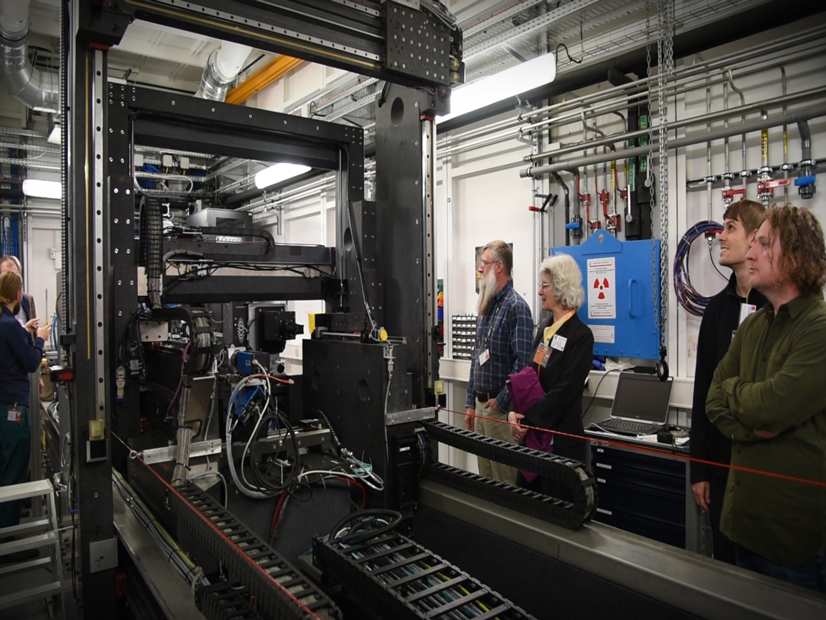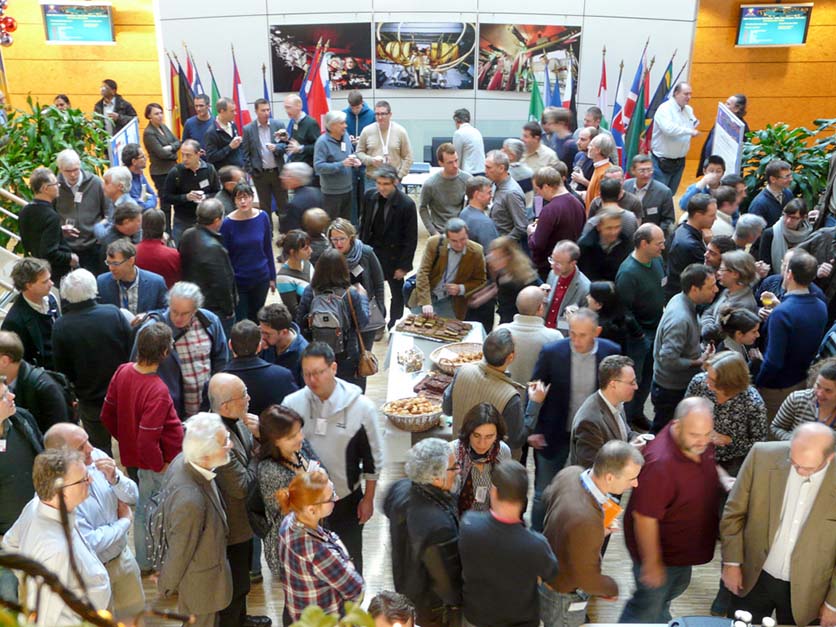- Home
- News
- General News
- EBS Workshop debates...
EBS Workshop debates future science at the ESRF
15-12-2016
On 8 & 9 December, the EBS Science Workshop brought together 300 members of the ESRF scientific community from across the world.
The two-day event was the opportunity for expert groups of users to discuss and openly exchange on the topics resulting from the call for Expressions of Interest (EoI) launched in 2015.
“The aim of the workshop is to identify the most impactful and scientifically promising projects that we can realise on the fantastic new source we are planning to install and start operating in 2020.” Harald Reichert, ESRF Director of Research.
In May 2016, following an analysis by user experts of the 48 EoI received, the ESRF Scientific Advisory Committee (SAC) selected eight topics for upgraded beamlines and a number of major refurbishment projects. Draft conceptual design reports (CDR) were elaborated at the ESRF for potential new beamlines to be constructed within the EBS project.
With the EBS workshop, the ESRF encouraged its scientific community to openly discuss and debate these CDRs and to further refine the scientific cases for the future orientation of the ESRF’s new beamlines. The CDRs were presented to the user community on the second day of the event.
“The workshop is full of tremendous ideas, creativity, and passion. There’s a huge turnout from those people who already use synchrotron radiation in their science. But the interesting question is how this is going to evolve because these new beamlines will open up to new areas of science and reach into new communities. I think that in the future, once the idea has become more concrete, we will see an even wider community engaging with the ESRF.” Andrew Harrison, CEO of Diamond Light Source (UK) and moderator of the EBS Science Workshop.
The EBS Science Workshop will produce 8 consolidated CDRs that will be analysed together with the SAC in early spring 2017. A consolidated experimental floor plan with all the ESRF beamlines will result. It will be analysed and projects ranked by the SAC before being finally submitted to the ESRF Council for final approval in June 2017.
“The EBS science workshop is an important event in that it will contribute to the selection of the new beamlines. It’s a unique opportunity to exchange with the community and, with the help of the expert groups, we hope to select the best projects for the future.” Jean Susini, ESRF Director of Research.
 |
 |
|
| Participants of the workshop during a visit of beamline ID06. ©ESRF/C. Navarette | A tremendous turnout from the ESRF scientific community. ©ESRF/C. Argoud |
The eight projects for upgraded beamlines
CDR1: A dedicated XPCS/CXDI beamline for dynamics studies and advanced imaging of complex systems. The new instrument will allow to unveil many new phenomena such as hidden ordering and disordering sub-millisecond processes during phase separation, diffusion kinetics, nucleation and growth processes under external stimuli and complex environments, as well as in vivo imaging of bacteria under micro-fluidic devices
CDR2: A beamline for hard X-ray diffraction microscopy, offering the opportunity to study bulk properties in mm-sized samples in 3D, using adapted tomographic techniques. The ability to directly characterize complex, multi-scale phenomena in situ is a key step towards formulating and validating multi-scale models that account for the entire heterogeneity of a material.
CDR3: A high throughput large field phase-contrast tomography beamline. For materials research and engineering, biology for imaging large samples (60 cm × 200 cm) on multiple scales: from the complete sample to sub-micrometre resolution imaging of selected regions, with a partial emphasis on automation and high throughput.
CDR4: A surface science beamline to exploit the extremely high brilliance of the new source to investigate chemical and physical processes on solid and liquid interfaces by surface sensitive X-ray techniques. The proposed beamline will provide unique capabilities for the in-situ studies on interfaces and nano-objects and will open new possibilities to investigate the dynamics of fundamental and applied processes in several fields ranging from material science (catalysis, electrochemistry, 2D materials) to soft matter and biochemistry (biomimetic membranes, polymers) including buried interfaces.
CDR5: An advanced high-flux nano-XRD beamline for science under extreme conditions. This high pressure X-ray diffraction beamline will take full advantage of the higher photon flux density and higher coherence of the new source.
CDR6: A facility for dynamic compression studies. This facility will extend the applications of the recently approved high power laser facility. The new beamline will cater for single shot and fast time resolved XRD and imaging.
CDR7: This project proposes to convert one branch of the energy dispersive XAS beamline ID24 to a scanning EXAFS beamline, providing optimal conditions for time-resolved and extreme conditions XAS. It will expand the capacity of the ESRF spectroscopy beamline portfolio to studies of highly dilute systems at extreme conditions and /or in time resolution.
CDR8: ESRF-EBS will allow the delivery of Henderson Limit X-ray doses in microseconds using submicron focal spots. Synchrotron serial crystallography on micro- and nano-crystals, combined with room temperature data collection and time-resolved studies, will become routinely accessible techniques.
Top image: ©ESRF/Montero Verdu



